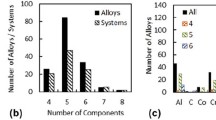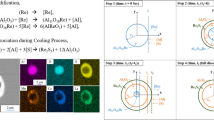Abstract
The magnetic properties of electrical steels are improved with additions of silicon and aluminum; however, these elements also promote the formation of non-metallic inclusions. The presence of non-metallic inclusions in electrical steels severely affects its magnetic properties. In this work, the effect of cooling rate, superheat, and refractory composition on the formation of non-metallic inclusions has been investigated. The evolution in chemical composition has been reported using a new representation employing pseudo-quinary phase diagrams. It has been found that the concentration of MnO in the non-metallic inclusions plays a big role to control its population density. A critical value has been identified above which it is possible to achieve a large decrease in the total number of non-metallic inclusions in electrical steels, in addition to this, it was also possible to define the influence of cooling rate, superheat, and refractory chemical composition on the composition and population density of non-metallic inclusions. It was found that increasing cooling rate and a change of crucible from alumina-based to MgO-based, both increase the population density of NMI, on the contrary, superheat decreases the population density, depending on the concentration of MnO in the inclusions.
















Similar content being viewed by others
References
H. Zhang, B. Johansson, R. Ahuja, L. Vitos: Comput. Mater. Sci. 2012, 55:269–272.
J-T. Park, J.A. Szpunar. J. Magn. Magn. Mater. 2009, 321(13): 1928-1932.
MF De Campos, JC Teixeira, FJG Landgraf: J. Magn. Magn. Mater., 2006, 301(1): 94–99.
K Matsumura, B Fukuda: IEEE Trans. Magn. 1984, 20(5):1533–38.
Ueshima Y, Sawada Y, Mizoguchi S, Kajioka H (1988) Metall. Trans. A, 20:1989–75.
Z.Liu, J. Wei, K. Cai: ISIJ Int. 2002, 42: 958–63.
Yosuke Kurosaki, Morio Shiozaki, Kazutaka Higashine, M Sumimoto: ISIJ Int. 1999, 39: 607–613.
Z. Feng, M. Changsong, W. Bo, Z. Peili, M. Zhigang, Z. Yi: Baosteel Technol. Res. 2011, 5: 41–45.
Feng Z., Lede M., Zhenyu Z., Bo W., Yi Z., Zhigang M. Baosteel Technol. Res. 2013, 7:12–19.
L. Zhang, B.G. Thomas .ISIJ Int. 2003, 43: 271–291.
P. Von Schweinichen, Z. Chen, D. Senk, A. Lob: Metall. Mater. Trans. A, 2013, 44: 5416–23.
H. Goto, K.-I. Miyazawa, W. Yanmada, K. Tanaka: ISIJ Int. 1995, 35: 708–714.
H. Goto, K. Miyazawa, K. Yamaguchi, S. Ogibayashi, K. Tanaka. ISIJ Int. 1994, 34: 414–19.
R. Diederichs, W. Bleck: Steel Res. Int. 2006, 77:202–09.
M El-Bealy, BG Thomas: Metall. Mater. Trans. B, 1996, 27: 689–93.
B.L. Bramfitt and A.O. Benscoter: Metallographer’s Guide-Practices and Procedures for Iron and Steels, 2006.
C.W. Yang, N. B. Lv, X.J. Zhuo, X. Wang, W. Wang: Iron Steel, 2010, 45: 34–36.
F. Schamber: Introduction to Automated Particle Analysis by Focused Electron Beam, Corporation, Editor 2009.
V. Singh, S.N. Lekakh, and K.D. Peaslee: SFSA Technical and Operating Conference[C]. Steel Founders’ Society of America, 2008.
R. L. Fullman: Trans. AIME, 1953, 197:447–52.
E. Zinngrebe, P. Seda, C. Van Hoek, B. Van Arendonk: ISIJ Int., 2013, 53(11): 1913–22.
P. Rocabois, J. Lehmann, H. Gaye, M. Wintz: J. Cryst. Growth, 1999, 198:838–43.
Acknowledgments
The authors are grateful for support from the National Science Foundation China (Grant No. 51274034, No. 51334002, and No. 51404019), State Key Laboratory of Advanced Metallurgy, Beijing Key Laboratory of Green Recycling and Extraction of Metals (GREM), the Laboratory of Green Process Metallurgy and Modeling (GPM2) and the High Quality steel Consortium (HQSC) at the School of Metallurgical and Ecological Engineering at University of Science and Technology Beijing (USTB), China.
Author information
Authors and Affiliations
Corresponding author
Additional information
Manuscript submitted May 24, 2015.
Rights and permissions
About this article
Cite this article
Luo, Y., Conejo, A.N., Zhang, L. et al. Effect of Superheat, Cooling Rate, and Refractory Composition on the Formation of Non-metallic Inclusions in Non-oriented Electrical Steels. Metall Mater Trans B 46, 2348–2360 (2015). https://doi.org/10.1007/s11663-015-0401-3
Published:
Issue Date:
DOI: https://doi.org/10.1007/s11663-015-0401-3




